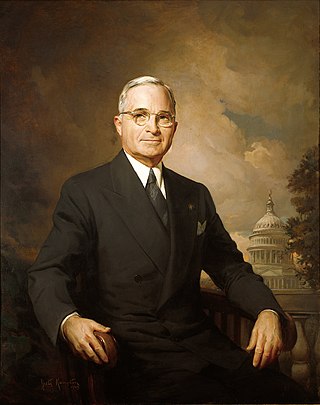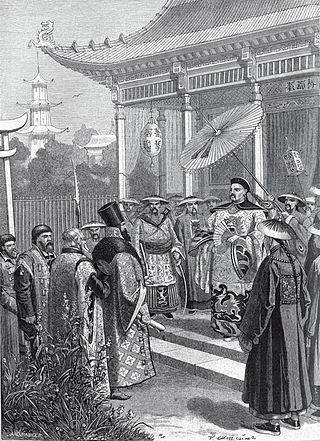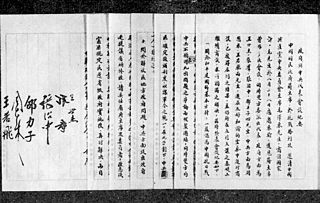Related Research Articles

The Cold War (1948–1953) is the period within the Cold War from the incapacitation of the Allied Control Council in 1948 to the conclusion of the Korean War in 1953.

The Chinese Civil War was fought between the Kuomintang-led government of the Republic of China and the forces of the Chinese Communist Party, with armed conflict continuing intermittently from 1 August 1927 until 7 December 1949, resulting in a Communist victory and subsequent control of mainland China.
The domino theory is a geopolitical theory which posits that increases or decreases in democracy in one country tend to spread to neighboring countries in a domino effect. It was prominent in the United States from the 1950s to the 1980s in the context of the Cold War, suggesting that if one country in a region came under the influence of communism, then the surrounding countries would follow. It was used by successive United States administrations during the Cold War as justification for American intervention around the world. Former U.S. President Dwight D. Eisenhower described the theory during a news conference on April 7, 1954, when referring to communism in Indochina as follows:
Finally, you have broader considerations that might follow what you would call the "falling domino" principle. You have a row of dominoes set up, you knock over the first one, and what will happen to the last one is the certainty that it will go over very quickly. So you could have a beginning of a disintegration that would have the most profound influences.

The Truman Doctrine is an American foreign policy that pledges American "support for democracies against authoritarian threats." The doctrine originated with the primary goal of containing Soviet geopolitical expansion during the Cold War. It was announced to Congress by President Harry S. Truman on March 12, 1947, and further developed on July 4, 1948, when he pledged to contain the communist uprisings in Greece and Soviet demands from Turkey. More generally, the Truman Doctrine implied American support for other nations threatened by Moscow. It led to the formation of NATO in 1949. Historians often use Truman's speech to Congress on March 12, 1947 to date the start of the Cold War.

The Sino-Soviet split was the gradual deterioration of relations between the People's Republic of China (PRC) and the Union of Soviet Socialist Republics (USSR) during the Cold War. This was primarily caused by doctrinal divergences that arose from their different interpretations and practical applications of Marxism–Leninism, as influenced by their respective geopolitics during the Cold War of 1947–1991. In the late 1950s and early 1960s, Sino-Soviet debates about the interpretation of orthodox Marxism became specific disputes about the Soviet Union's policies of national de-Stalinization and international peaceful coexistence with the Western Bloc, which Chinese founding father Mao Zedong decried as revisionism. Against that ideological background, China took a belligerent stance towards the Western world, and publicly rejected the Soviet Union's policy of peaceful coexistence between the Western Bloc and Eastern Bloc. In addition, Beijing resented the Soviet Union's growing ties with India due to factors such as the Sino-Indian border dispute, and Moscow feared that Mao was too nonchalant about the horrors of nuclear warfare.

George Frost Kennan was an American diplomat and historian. He was best known as an advocate of a policy of containment of Soviet expansion during the Cold War. He lectured widely and wrote scholarly histories of the relations between the USSR and the United States. He was also one of the group of foreign policy elders known as "The Wise Men."

Containment was a geopolitical strategic foreign policy pursued by the United States during the Cold War to prevent the spread of communism after the end of World War II. The name was loosely related to the term cordon sanitaire, which was containment of the Soviet Union in the interwar period.
In American politics, the China lobby consisted of advocacy groups calling for American support for the Republic of China during the period from the 1930s until US recognition of the People's Republic of China in 1979, and then calling for closer ties with the PRC thereafter.

The First Taiwan Strait Crisis was a brief armed conflict between the Communist People's Republic of China (PRC) and the Nationalist Republic of China (ROC) in Taiwan. The conflict focused on several groups of islands in the Taiwan Strait that were held by the ROC but were located only a few miles from mainland China.

The Formosa Resolution of 1955 was a joint resolution passed by the U.S. Senate and signed by U.S. President Dwight D. Eisenhower on January 29, 1955, to counteract the threat of an invasion of Taiwan by the People's Republic of China (PRC). The resolution gave the U.S. president the authority "to employ the Armed Forces of the United States as he deems necessary for the specific purpose of securing and protecting Formosa and the Pescadores against armed attack [by the Communists]".

The Sino-Soviet Treaty of Friendship, Alliance and Mutual Assistance, or Sino-Soviet Treaty of Friendship and Alliance for short, was a bilateral treaty of alliance, collective security, aid and cooperation concluded between the People's Republic of China and the Union of Soviet Socialist Republics on February 14, 1950. It superseded the previous Sino-Soviet treaty signed by the Kuomintang government.

Prior to the 17th century, China and Russia were on opposite ends of Siberia, which was populated by independent nomads. By about 1640 Russian settlers had traversed most of Siberia and founded settlements in the Amur River basin. From 1652 to 1689, China's armies drove the Russian settlers out, but after 1689, China and Russia made peace and established trade agreements.
The aftermath of the Korean War set the tone for Cold War tension between superpowers. The Korean War was important in the development of the Cold War, as it showed that the two superpowers, United States and Soviet Union, could fight a "limited war" in a third country. The "limited war" or "proxy war" strategy was a feature of conflicts such as the Vietnam War and the Soviet War in Afghanistan, as well as wars in Angola, Greece, and the Middle East.

Harry S. Truman's tenure as the 33rd president of the United States began on April 12, 1945, upon the death of president Franklin D. Roosevelt, and ended on January 20, 1953. He had been vice president for only 82 days when he succeeded to the presidency. Truman, a Democrat from Missouri, ran for and won a full four-year term in the 1948 presidential election, in which he narrowly defeated Republican nominee Thomas E. Dewey and Dixiecrat nominee Strom Thurmond. Although exempted from the newly ratified Twenty-second Amendment, Truman did not run for a second full term in the 1952 presidential election because of his low popularity. He was succeeded by Republican Dwight D. Eisenhower.

The Double Tenth Agreement, formally known as the Summary of Conversations Between the Government and Representatives of the Communist Party of China, was an agreement between the Kuomintang (KMT) and the Chinese Communist Party (CCP) that was concluded on 10 October 1945 after 43 days of negotiations. CCP Chairman Mao Zedong and United States Ambassador to China Patrick J. Hurley flew together to Chongqing on 27 August 1945 to begin the negotiations. The outcome was that the CCP acknowledged the KMT as the legitimate government, while the KMT in return recognised the CCP as a legitimate opposition party. The Shangdang Campaign, which began on 10 September, came to an end on 12 October as a result of the announcement of the agreement.
In American political discourse, the "loss of China" is the unexpected Chinese Communist Party coming to power in mainland China from the U.S.-backed Chinese Kuomintang government in 1949 and therefore the "loss of China to communism."

The Chinese Communist Revolution was a social and political revolution that culminated in the establishment of the People's Republic of China in 1949. For the preceding century, China had faced escalating social, economic, and political problems as a result of Western imperialism, Japanese imperialism, and the decline of the Qing dynasty. Cyclical famines and an oppressive landlord system kept the large mass of rural peasantry poor and politically disenfranchised. The Chinese Communist Party (CCP) was formed in 1921 by young urban intellectuals inspired by European socialist ideas and the success of the Bolshevik Revolution in Russia. The CCP originally allied itself with the nationalist Kuomintang party against the warlords and foreign imperialist forces, but the Shanghai Massacre of Communists ordered by Kuomintang (KMT) leader Chiang Kai-shek in 1927 forced them into the Chinese Civil War spanning more than two decades.
The Vietnam War was a major event that shaped the course of the world in the second half of the 20th century. Although it was a regional conflict that occurred on the Indochinese Peninsula, it also affected the strategic interests of the People's Republic of China, the United States and the Soviet Union as well as the relations between these great powers. China, in particular, also played an important role in the Vietnam wars starting from the First Indochina War. China militarily supported North Vietnam by fighting South Vietnam and the United States in the Vietnam War, as well as providing extensive logistical, training, and material aid.

The main issues of the United States foreign policy during the 1945–1953 presidency of Harry S. Truman include:

The Cold War in Asia was a major dimension of the worldwide Cold War that shaped diplomacy and warfare from the mid-1940s to 1991. The main countries involved were the United States, the Soviet Union, China, North Korea, South Korea, North Vietnam, South Vietnam, Cambodia, Afghanistan, Iran, Iraq, India, Bangladesh, Pakistan, Indonesia, and Taiwan. In the late 1950s, divisions between China and the Soviet Union deepened, culminating in the Sino-Soviet split, and the two then vied for control of communist movements across the world, especially in Asia.
References
- ↑ Mao, 2015
- ↑ Schonberger, Howard (1977), "The Japan Lobby in American Diplomacy, 1947-1952", Pacific Historical Review , 46 (3): 327–359, doi:10.2307/3637501, JSTOR 3637501
- ↑ H. Bradford Westerfield, Foreign Policy and Party Politics (1972), ch. 12